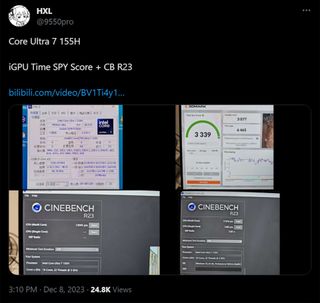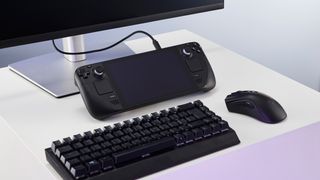Leaked 3DMark score puts Intel's mid-tier Meteor Lake on par with AMD's best handheld PC processor, for gaming at least
Benchmarks don't always show you the whole picture but it does look promising for gaming on an integrated Intel GPU.

With the expected launch of Intel's Meteor Lake architecture being just around the corner, benchmark scores are getting leaked left, right, and centre. A 3DMark Time Spy test for a Core 7 Ultra 155H puts it slightly faster than AMD's Ryzen Z1 Extreme, which is used in lots of handheld gaming devices. Given that they have the same power limit, it suggests that Team Red might not have the pocket PC market all to itself in 2024.
I spotted this snippet of information on X/Twitter, as posted by habitual leaker HXL. The screenshots reportedly show some benchmark results for a 28W Core 7 Ultra 155H. This CPU is based on Intel's forthcoming Meteor Lake architecture, which comprises multiple tiles for graphics, compute, IO, and general housekeeping duties.
The compute tile houses six P-cores and eight E-cores, 22 threads in total, with a further two E-cores tucked away in another tile. There's less knowledge about the GPU tile but it's generally thought to have eight Xe cores and if we assume that Intel hasn't changed the structure of its Arc graphics design for Meteor Lake, that's a total of 1,024 shaders.
Anyway, the important bit is that the chip achieved a Time Spy result of 3,339 and the image shows a graphics score of 3,077 and a CPU score of 6,465. To see what those figures are like, I ran the same benchmark on the Asus ROG Ally, which sports AMD's Ryzen Z1 Extreme APU.
You can see in my Time Spy results of that run the Asus handheld got an overall score of 3,150 while the graphics score was 2,834 and the CPU score was 8,574. These figures were achieved with the Ally docked and running in its 30W Turbo mode, so that's as good as it's going to get for the ROG device. Taken on face value, the Z1 Extreme produced a 33% better CPU result but an 8% lower graphics score.

AMD's processor has eight Zen 4 cores and if Time Spy is being run entirely on the Meteor Lake P-cores, this might explain why there's a 33% difference between the two. If the E-cores are being used, then it's a different story, and we'd need to know a lot more about what's going on with the clock speeds during the tests to analyse it further.
Intel's Arc GPUs can be quite twitchy when it comes to gaming performance, especially in older DirectX 9 and 10 games, but it's generally fine in newer ones, especially with the constant driver development. Time Spy is pretty heavy with shaders and the Alchemist architecture is good in these situations; however, that doesn't always translate to being the same in actual games.
The biggest gaming news, reviews and hardware deals
Keep up to date with the most important stories and the best deals, as picked by the PC Gamer team.
Indeed, the Alchemist GPUs were tuned for 3DMark around launch and their synthetic benchmarks told a very different story to the actual per-game benchmarks. That delta has been significantly slashed with recent driver releases, however.
The Arc tile being tested here doesn't seem to be massively better than the Radeon 780M in the Z1 Extreme, but at least it's on par in this particular test. Real-time gameplay will show a broad range of differences but as a rough gauge, the Time Spy result is probably quite close to how things will be on average.

Steam Deck OLED review: Our verdict on Valve's handheld.
Best Steam Deck accessories: Get decked out.
Steam Deck battery life: What's the real battery life?
Best handheld gaming PC: What's the best travel buddy?
The X/Twitter post also shows some Cinebench R23 results, with the Core 7 Ultra 155H getting a multicore score of 11,616 and a single core of 1,483. By comparison, the ROG Ally got 13,896 and 1,717, respectively. That puts Intel's chip 14 to 16% behind AMD's but it's closer in performance than in the Time Spy test.
Of course, there's no way to verify the claimed result for the Core 7 Ultra 155H but if we assume that it's correct and representative of what the chip can actually do, it's not too bad for a 28W processor. For me, it's an ideal candidate to be used in a handheld gaming PC, as raw CPU performance is less important than outright graphics power.
Competition in any segment is good for the consumer, so if Intel can produce these Meteor Lake processors at the same price as AMD can churn out its APUs, then we could see some new handheld PCs in 2024 sporting Intel processors.
We know that Emdoor is certainly toying with the idea and the overall gaming experience with a Meteor Lake laptop is pretty encouraging for the size of the GPU inside. I can't wait to see what new devices come out next year, as although I'm a newbie to this whole handheld thing, I'm becoming increasingly addicted to pocket PCs!

Nick, gaming, and computers all first met in 1981, with the love affair starting on a Sinclair ZX81 in kit form and a book on ZX Basic. He ended up becoming a physics and IT teacher, but by the late 1990s decided it was time to cut his teeth writing for a long defunct UK tech site. He went on to do the same at Madonion, helping to write the help files for 3DMark and PCMark. After a short stint working at Beyond3D.com, Nick joined Futuremark (MadOnion rebranded) full-time, as editor-in-chief for its gaming and hardware section, YouGamers. After the site shutdown, he became an engineering and computing lecturer for many years, but missed the writing bug. Cue four years at TechSpot.com and over 100 long articles on anything and everything. He freely admits to being far too obsessed with GPUs and open world grindy RPGs, but who isn't these days?
Most Popular




